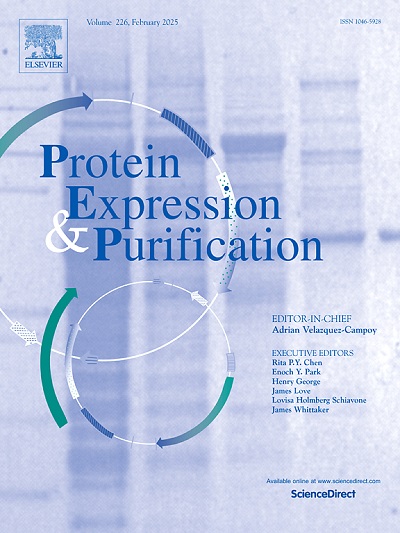利用大肠杆菌表达和纯化结核分枝杆菌f420依赖性葡萄糖-6-磷酸脱氢酶。
IF 1.4
4区 生物学
Q4 BIOCHEMICAL RESEARCH METHODS
引用次数: 0
摘要
自从在结核分枝杆菌(Mtb)中发现f420依赖性酶以来,f420依赖性酶已被确定为重要的药物靶点和潜在的工业生物催化剂,包括用于其他顽固底物的生物修复。Mtb-FGD1利用葡萄糖6-磷酸(G6P)作为电子供体还原F420。目前Mtb-FGD1的表达系统使用耻垢分枝杆菌作为宿主,因为它倾向于在大肠杆菌中形成包涵体。然而,利用耻垢分枝杆菌大规模生产重组蛋白是缓慢而昂贵的,而且这种生物通常不被认为是安全的。在这里,我们报告了一种更快、更便宜和更安全的方法,在大肠杆菌中使用冷适应GroEL/ES作为伴侣表达全功能Mtb-FGD1。我们的方法产生每升(L)培养约70毫克的蛋白质。纯化后的酶催化F420还原为F420。H2在G6P存在下,以及F420的再氧化。当与Tfu-FNO偶联时,H2变成F420, Tfu-FNO是一种耐热氧化还原酶,利用F420进行NADPH的可逆氧化。后一项发现为Mtb-FGD1作为工业生物催化剂或用于孔雀石绿、苦味酸和黄曲霉毒素等环境污染物的解毒提供了机会。本文章由计算机程序翻译,如有差异,请以英文原文为准。
Expression and purification of Mycobacterium tuberculosis F420-dependent glucose-6-phosphate dehydrogenase enzyme using Escherichia coli
Since their discovery in Mycobacterium tuberculosis (Mtb), F420-dependent enzymes have been identified as both important drug targets and potential industrial biocatalysts, including for bioremediation of otherwise recalcitrant substrates. Mtb-FGD1, utilizes glucose 6-phosphate (G6P) as an electron donor for the reduction of F420. Current expression systems for Mtb-FGD1 use Mycobacterium smegmatis as host, because of the tendency for it to form inclusion bodies in E. coli. However, large scale recombinant protein production using M. smegmatis is slow and costly and the organism is not generally recognized as safe. Here, we report a faster, cheaper and safer approach for the expression of fully functional Mtb-FGD1 in E. coli using cold-adapted GroEL/ES as chaperones. Our approach yielded ∼70 mg of protein per litre (L) of culture. The purified enzyme catalysed the reduction of F420 to F420.H2 in the presence of G6P, and the re-oxidation of the F420.H2 to F420 when coupled to Tfu-FNO, which is a thermostable oxidoreductase that utilizes F420 for the reversible oxidation of NADPH. This latter finding provides opportunity for the utilization of Mtb-FGD1 as an industrial biocatalyst or in the detoxification of environmental contaminants such as malachite green, picrate and aflatoxin.
求助全文
通过发布文献求助,成功后即可免费获取论文全文。
去求助
来源期刊

Protein expression and purification
生物-生化研究方法
CiteScore
3.70
自引率
6.20%
发文量
120
审稿时长
32 days
期刊介绍:
Protein Expression and Purification is an international journal providing a forum for the dissemination of new information on protein expression, extraction, purification, characterization, and/or applications using conventional biochemical and/or modern molecular biological approaches and methods, which are of broad interest to the field. The journal does not typically publish repetitive examples of protein expression and purification involving standard, well-established, methods. However, exceptions might include studies on important and/or difficult to express and/or purify proteins and/or studies that include extensive protein characterization, which provide new, previously unpublished information.
 求助内容:
求助内容: 应助结果提醒方式:
应助结果提醒方式:


